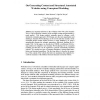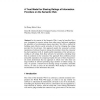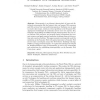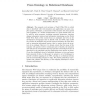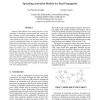ER
2006
Springer
14 years 3 months ago
2006
Springer
An important milestone in the evolution of the Web is the Semantic Web: a Web in which the semantics of the available content and functionality is made explicit. Web design methods...
CSWWS
2006
14 years 3 months ago
2006
In the context of the Semantic Web, it may be beneficial for a user (consumer) to receive ratings from other users (advisors) regarding the reliability of an information source (pr...
CSWWS
2006
14 years 3 months ago
2006
Abstract. Heterogeneity is an inherent characteristic of open and distributed environments like the Internet that can hamper Web resources and Web services from successful interope...
CSWWS
2006
14 years 3 months ago
2006
The realization of Semantic Web vision is based on the creation and use of semantic web content which needs software tools both for semantic web developers and end users. Over the ...
ER
2004
Springer
14 years 3 months ago
2004
Springer
The semantic web envisions a World Wide Web in which data is described with rich semantics and applications can pose complex queries. Ontologies, a cornerstone of the semantic web,...
EKAW
2004
Springer
14 years 3 months ago
2004
Springer
The objective of the Semantic Web is to make the Web amenable to computer processing, and hence to improve the value that humans can obtain from it. One of the oft-touted user bene...
EEE
2004
IEEE
14 years 3 months ago
2004
IEEE
Semantic Web endeavors have mainly focused on issues pertaining to knowledge representation and ontology design. However, besides understanding information metadata stated by subj...
CIA
2006
Springer
14 years 3 months ago
2006
Springer
In this topical1 paper we try to give an analysis and overview of the current state of Semantic Web research. We point to different interpretations of the Semantic Web as the reaso...
CCGRID
2006
IEEE
14 years 3 months ago
2006
IEEE
This paper presents an ontology-based conceptual mapping framework that translates a formal and visually rich business process modeling (BPM) language, Fundamental Business Proces...
CAISE
2006
Springer
14 years 3 months ago
2006
Springer
This paper introduces an approach to mapping relational database contents to ontologies. The current effort is motivated by the need of including into the Semantic Web volumes of w...
